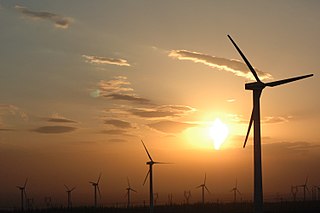
Wind power is the use of wind energy to generate useful work. Historically, wind power was used by sails, windmills and windpumps, but today it is mostly used to generate electricity. This article deals only with wind power for electricity generation. Today, wind power is generated almost completely with wind turbines, generally grouped into wind farms and connected to the electrical grid.
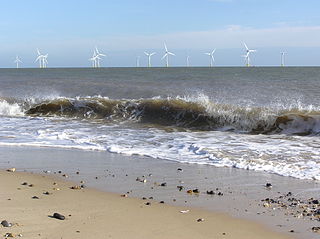
The Scroby Sands Wind Farm is a wind farm located on the Scroby Sands sandbank in the North Sea, 2.5 kilometres (1.6 mi) off the coast of Great Yarmouth in eastern England, United Kingdom. It was commissioned in March 2004 by Powergen Renewables Offshore, a division of E.ON UK. It has a nameplate capacity of 60 megawatts and is able to produce power to supply 41,000 households. Between 2005 and 2010, its capacity factor was between 26 and 32%. Its levelised cost has been estimated at £105/MWh.

A wind farm or wind park, also called a wind power station or wind power plant, is a group of wind turbines in the same location used to produce electricity. Wind farms vary in size from a small number of turbines to several hundred wind turbines covering an extensive area. Wind farms can be either onshore or offshore.
Crookwell Wind Farm, located at Crookwell west of Goulburn, New South Wales, consists of eight 600 kW wind turbines giving a total capacity of 4.8 MW. It was the first grid-connected wind farm in Australia when built by Pacific Power in 1998. It is now owned by Tilt Renewables.

The United Kingdom is the best location for wind power in Europe and one of the best in the world. The combination of long coastline, shallow water and strong winds make offshore wind unusually effective.

Windy Hill Wind Farm is a wind power station near Ravenshoe on the Atherton Tableland, Queensland, Australia. It has 20 wind turbines with a generating capacity of 12 MW of electricity, providing enough power for about 3,500 homes. The cost of the project was A$20 million. It was the second wind farm to be constructed in Queensland after the 0.45Mw station on Thursday Island (1997).

Greater Gabbard is a 504 MW wind farm, built on sandbanks 23 kilometres (14 mi) off the coast of Suffolk in England at a cost of £1.5 billion. It was completed on 7 September 2012 with all of the Siemens SWT3.6–107 turbines connected. Developed as a joint venture between Airtricity and Fluor, it is now jointly owned by SSE Renewables and RWE.

Blood Hill is a wind farm near Hemsby in Norfolk, England. It is the smallest windfarm owned by E.ON; taking up 3 hectares. It has a nameplate capacity of 2.25MW which is enough to power 1000 homes at peak. There were 10 Vestas V27-225 kW turbines which were 30 metres tall and stand on top of Blood Hill. They are visible from the villages of Hemsby and Winterton-on-Sea. Blood Hill began operating in December 1992 and was one of the first windfarms in the United Kingdom.

Burton Wold Wind Farm is a wind farm located near Burton Latimer in the English county of Northamptonshire, UK. The farm was developed by Your Energy Ltd, is owned by Mistral Windfarms and operated by Engineering Renewables Ltd. E.ON UK is buying the electricity output of the project under a long-term power purchase agreement. The farm is spread over three hectares. It has an installed capacity of 20 MW and generate on average around 40,000,000 units of electricity annually.

The Kentish Flats Offshore Wind Farm is a wind farm located off the coast of Kent, England on a large, flat and shallow plateau just outside the main Thames shipping lanes. The wind farm is operated by Vattenfall.
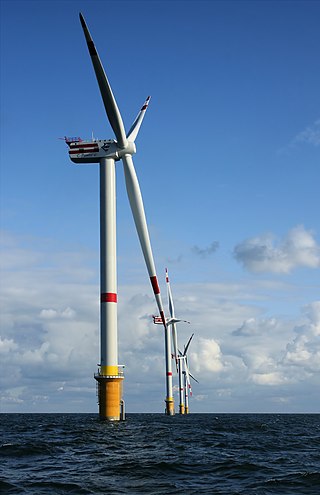
A wind turbine is a device that converts the kinetic energy of wind into electrical energy. As of 2020, hundreds of thousands of large turbines, in installations known as wind farms, were generating over 650 gigawatts of power, with 60 GW added each year. Wind turbines are an increasingly important source of intermittent renewable energy, and are used in many countries to lower energy costs and reduce reliance on fossil fuels. One study claimed that, as of 2009, wind had the "lowest relative greenhouse gas emissions, the least water consumption demands and the most favorable social impacts" compared to photovoltaic, hydro, geothermal, coal and gas energy sources.

The Lincs Wind Farm is a 270 MW offshore wind farm 8 kilometres (5.0 mi) off Skegness on the east coast of England. The total cost of the project is estimated at £1 billion including electrical transmission links. The farm was completed in 2013. It is adjacent to the smaller Lynn and Inner Dowsing Wind Farm.
Langley Park Wind Farm is a wind farm near Langley Park, County Durham, England. It was developed by EDF Energy and is operated by Cumbria Wind Farms, the farm has a nameplate capacity of 8.2 MW, containing four REpower Systems' MM82 turbines each rated at 2.05MW.

Blyth Harbour Wind Farm is a coastal wind farm located in East Bedlington along the East Pier of the Port of Blyth. Commissioned in January 1993 it consists of nine 0.3 MW WindMaster turbines giving a total capacity of 2.7 MW. It was developed by AMEC Wind and is owned by Hainsford Developments Limited.

GE Wind is a division of GE Vernova. The company manufactures and sells wind turbines to the international market. In 2018, GE Wind was the fourth largest wind turbine manufacturer in the world. Vic Abate is the CEO of GE Vernova’s Wind businesses.

The Delabole wind farm was the first commercial onshore wind farm built in the United Kingdom, in November 1991. This field of wind turbines was initially developed by Windelectric Management Ltd.
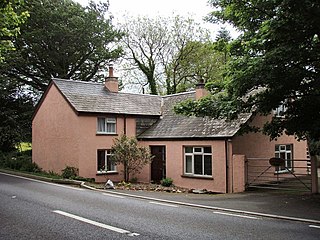
Cold Northcott is a hamlet in Cornwall, England, UK. It is on the A395 road two miles southeast of Hallworthy. It is in the civil parish of St Clether.
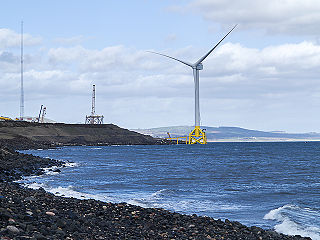
Methil Offshore Wind Turbine is a demonstrator site for experimental offshore wind turbines at Fife Energy Park off the coast of Methil, Fife in Scotland.
Dogger Bank Wind Farm is a group of offshore wind farms under construction 130 to 200 kilometres off the east coast of Yorkshire, England in the North Sea. It is considered to be the world's largest offshore windfarm. It was developed by the Forewind consortium, with three phases envisioned - first phase, second phase and third phase. In 2015, the third phase was abandoned, while the first and second phases were granted consent. It was initially expected that the Dogger Bank development will consist of four offshore wind farms, each with a capacity of up to 1.2 GW, creating a combined capacity of 4.8 GW. As of 2024, a total of 8.1 GW generating capacity is expected to be installed on Dogger Bank.

The East Anglia Array is a proposed series of offshore wind farms located around 30 miles off the east coast of East Anglia, in the North Sea, England. It has begun with the currently operational East Anglia ONE, that has been developed in partnership by ScottishPower Renewables and Vattenfall. Up to six individual projects could be set up in the area with a maximum capacity of up to 7.2 GW. The first project, East Anglia ONE at 714 MW, received planning consent in June 2014 and contracts in April 2016. Offshore construction began in 2018 and the project was commissioned in July 2020. It is expected to cost £2.5 billion.



















